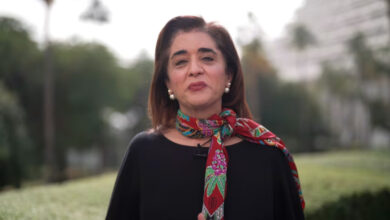Although the Middle East contributes relatively little to greenhouse gas emissions on a global level, several studies have shown that the region is extremely vulnerable to the effects of climate change. These effects include severe droughts, water shortages, and flooding in coastal areas.
The United Nations Development Programme (UNDP) published a report last year entitled Mapping of Climate Change Threats and Human Development Impacts in the Arab Region. It revealed that with hotter, drier and less predictable climates, the amount of water running into the region's streams and rivers is set to fall by 20 to 30 percent by 2050. Expected consequences include food insecurity and more-rapid desertification, the report says.
Since the region is home to six of the world's ten most water-scarce countries, the consequences could be far-reaching. Its citizens currently have access to an average of 1000 cubic meters of water a year, a figure seven times below the world average, and the figure is expected to shrink to 460 cubic meters by 2025.
According to a report released last week by the World Meteorological Organization (IMO), all indicators point to an expected 20 percent decrease in the water resources of the Ethiopian Plateau, with a corresponding reduction in Nile water flowing to downstream countries. The report estimates an annual reduction of more than 11 billion cubic meters in Egypt and Sudan alone due to the effects of climate change.
Meanwhile, the region is also at risk from rising sea levels. The areas at particular risk include small-island states like Bahrain, as well as natural and man-made islands in the Arabian Gulf, plus the Nile Delta. For Egypt, where over 50 percent of the population lives within 100 kilometers of the coastline, at least 6 to 8 million people would be displaced.
Mohamed al-Raey, environmental advisor to the Arab Academy of Science and Technology and chairman of the Environment Committee at the Supreme Council of Egyptian Universities, has spoken extensively in recent years about the many problems that a rise in sea level could cause for Egypt. Speaking to Al-Masry Al-Youm, he estimates that areas up to 30 kilometers inland will suffer if Egypt does not take radical measures.
“Roughly 10 to 12 percent of the Delta is in direct danger of flooding," says Raey. "The rest will suffer from severe saltwater intrusion. The biggest problem would be the groundwater. With rising seawater, more salt will reach the groundwater, which will affect the chemical makeup of the soil. Productivity of the land will fall, and some crops will not be able to survive in these circumstances. This means millions of people will be displaced and thousands of hectares of agricultural land will be lost.”
Some hope comes from a pan-Arab survey conducted by the Arab Forum for Environment and Development (AFED) last year. The study found that 98 percent of those surveyed believe that the climate is changing, thus showing that the Arab public – unlike its Western counterpart – is virtually unanimous in the belief that climate change is real. The survey also showed that skepticism concerning the facts and causes of climate change — either denying it entirely or ascribing it to natural causes — is on the decline.
But there remains an urgent need for the region to enact policies that mitigate the effects of climate change. According to Wael Hmaidan, executive director of IndyACT, a group of independent activists working with environmental issues, the future lies in supporting countries in developing a low-carbon development strategy. Speaking to Al-Masry Al-Youm from Durban, Hmaidan explains, “To save ourselves from climate change, we need to transform into a low-carbon society. To do that, we need to develop long-term strategies that would outline the path… IndyACT thinks that such a decision would be a big step forward to save the planet from climate change and is lobbying for this.”
Environmentalists feel that swift action needs to be taken in the region, considering the rapid increase in energy consumption and greenhouse emissions. The Arab world's emissions are growing at one of the fastest rates in the world, with Kuwait, the United Arab Emirates, and Qatar leading the way as the region’s largest emitters per capita.
“While global carbon emissions per capita have only marginally increased over the last 30 years, the emissions of the average Arab have almost doubled. At current rates, it is expected that the emissions of an average Arab person will exceed the global average in the next five years, with no sign of a slowing down,” according to a recent study conducted by Carboun, an advocacy initiative promoting sustainability and environmental conservation in the Middle East.
Ironically, Qatar has been chosen to host next year's Conference of the Parties — known as COP18 under The United Nations Framework Convention on Climate Change (UNFCCC). If this year's discussions in Durban (known as COP17) fail to secure a future for the Kyoto Protocol, which expires in 2012, next year's talks will need to focus on how to secure a legally binding global deal to cut emissions that can come into force between 2015 and 2020 – definitely not an easy undertaking in light of ongoing political battles.
Disputes about how to respond to climate change once revolved around the divide between rich and poor. The premise was that the rich are responsible since they are the source of greenhouse gas emissions that lead to global warming. Consequently, the 1992 Climate Convention and the 1997 Kyoto Protocol — established to decrease these emissions — understandably envisaged emissions curbs for wealthy nations only. The reductions amount to an average of 5 percent against 1990 levels over the five-year period from 2008 through 2012.
However, since then, there has been a shift. No longer is this divide reflective of reality, since the largest developing countries — namely China, India and Brazil — have become major producers of greenhouse gas.
With this in mind, the battle lines have already been drawn in Durban. On one side stands an obstinate group of big emitters, developed and developing, who are in opposition to the prospect of any legally binding targets being etched in a new treaty applicable post-2012. On the other side stands a growing alliance of vulnerable countries, including the small island states, the European Union, and several Latin American nations. These countries want a global deal to be reached by 2015, and to be in place by 2020, with ambitious action in the meantime, particularly since the stakes have grown; the International Energy Agency (IEA) warned earlier this month that the world only has five years to create a system to cap global warming at 2°C. If the warming gets more severe, scientists argue, climate change becomes catastrophic and irreversible.
Any real progress depends on an accord in which China and the United States, the world's top emitters, agree on binding action under a wider deal by 2015. The fact that they have been resisting this for years casts doubt on the prospects for success.




